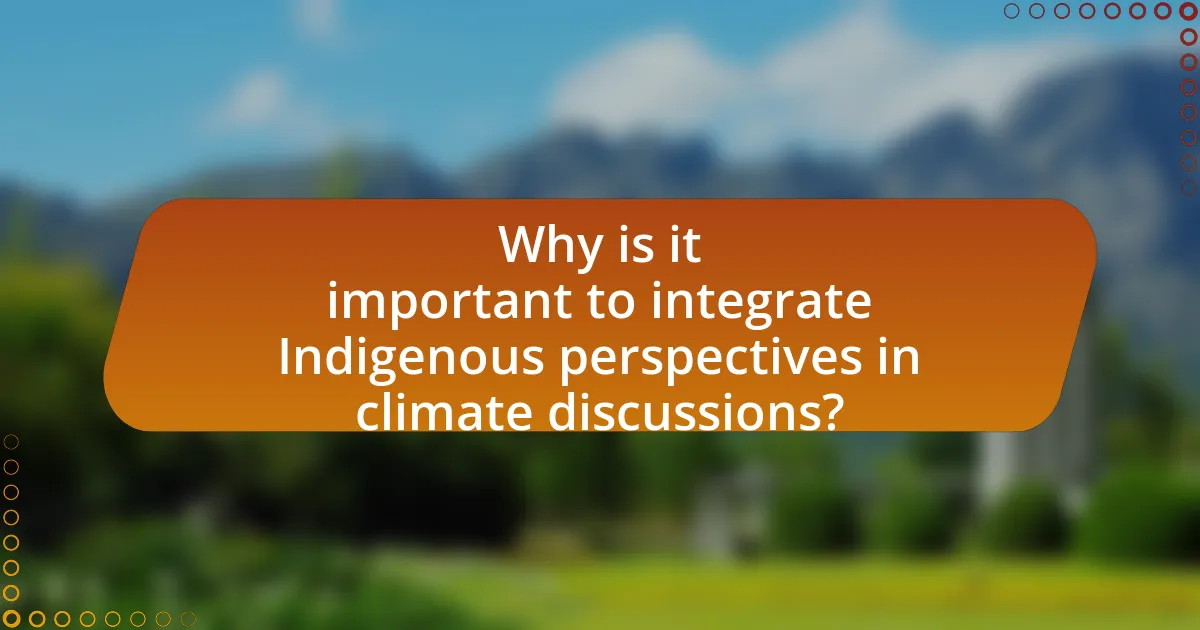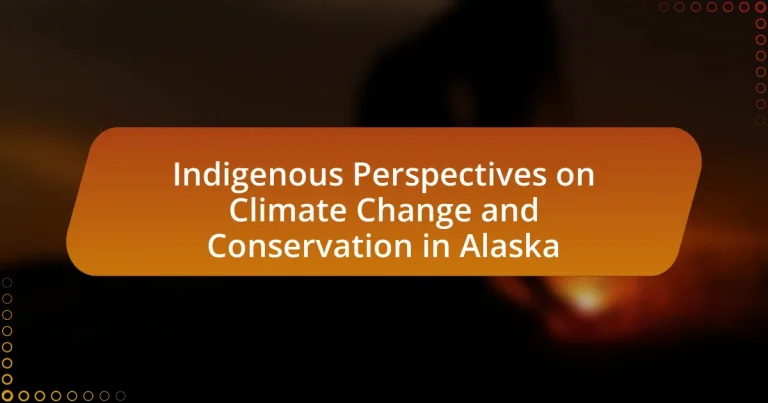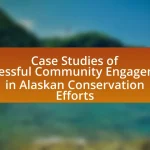The article focuses on Indigenous perspectives regarding climate change and conservation in Alaska, highlighting the deep interconnectedness between the environment, culture, and community well-being among Indigenous peoples. It discusses how climate change poses significant threats to traditional lifestyles, food security, and cultural practices, as observed through changes in wildlife patterns and subsistence activities. The article emphasizes the importance of traditional ecological knowledge (TEK) in informing sustainable practices and adaptation strategies, while also addressing the challenges faced by Indigenous communities, such as land rights issues and underrepresentation in decision-making processes. Furthermore, it outlines the necessity of integrating Indigenous knowledge into climate discussions and policies to enhance conservation efforts and promote environmental sustainability.

What are Indigenous Perspectives on Climate Change and Conservation in Alaska?
Indigenous perspectives on climate change and conservation in Alaska emphasize the interconnectedness of the environment, culture, and community well-being. Indigenous peoples view climate change not only as an environmental issue but also as a threat to their traditional ways of life, food security, and cultural practices. For instance, the Alaska Native community has observed significant changes in wildlife patterns, sea ice melting, and altered migration routes, which directly impact subsistence hunting and fishing practices.
Research conducted by the Alaska Native Tribal Health Consortium highlights that Indigenous knowledge systems, which have been developed over thousands of years, provide valuable insights into sustainable practices and adaptation strategies. This knowledge is increasingly recognized as essential for effective climate action and conservation efforts, as it incorporates a holistic understanding of ecosystems and emphasizes stewardship of the land.
How do Indigenous communities in Alaska perceive climate change?
Indigenous communities in Alaska perceive climate change as a significant threat to their way of life and cultural practices. They observe changes such as melting ice, altered wildlife migration patterns, and unpredictable weather, which directly impact their subsistence activities like hunting and fishing. For instance, a study by the Alaska Native Tribal Health Consortium highlights that many Indigenous people report increased difficulty in accessing traditional food sources due to these environmental changes. This perception is rooted in their deep connection to the land and reliance on natural resources, making climate change not just an environmental issue but a cultural and existential one.
What traditional knowledge informs Indigenous views on climate change?
Traditional ecological knowledge (TEK) informs Indigenous views on climate change, emphasizing the interconnectedness of ecosystems and the importance of observing natural patterns over generations. This knowledge includes insights on seasonal changes, animal behaviors, and plant growth, which have been passed down through oral traditions and practical experiences. For instance, Indigenous communities in Alaska have documented shifts in wildlife migration patterns and changes in ice conditions, reflecting their deep understanding of environmental changes. Such observations are critical for adapting to climate impacts and informing sustainable practices, demonstrating the validity of TEK in addressing contemporary climate challenges.
How do cultural beliefs shape Indigenous responses to climate change?
Cultural beliefs significantly shape Indigenous responses to climate change by influencing their understanding of environmental stewardship and community resilience. Indigenous cultures often view the land, water, and wildlife as interconnected and sacred, leading to a holistic approach to climate adaptation that prioritizes traditional ecological knowledge. For instance, many Indigenous groups in Alaska incorporate ancestral practices and spiritual beliefs into their climate strategies, emphasizing the importance of maintaining relationships with nature. This is evidenced by the incorporation of traditional hunting and fishing practices that adapt to changing ecosystems, which reflects a deep-rooted belief in the responsibility to care for the environment. Furthermore, studies show that Indigenous communities actively engage in climate advocacy, drawing on their cultural narratives to highlight the urgency of climate action, thereby reinforcing their role as stewards of the land.
What role does conservation play in Indigenous perspectives?
Conservation plays a fundamental role in Indigenous perspectives by emphasizing the interconnectedness of people, land, and resources. Indigenous communities view conservation not merely as a practice but as a cultural imperative that sustains their identity, traditions, and livelihoods. For instance, many Indigenous groups in Alaska engage in sustainable practices that reflect their deep understanding of local ecosystems, which has been passed down through generations. This relationship is evidenced by their traditional ecological knowledge, which informs resource management and conservation strategies, ensuring the preservation of biodiversity and cultural heritage.
How do Indigenous practices contribute to conservation efforts?
Indigenous practices contribute to conservation efforts by integrating traditional ecological knowledge with sustainable resource management. These practices, rooted in a deep understanding of local ecosystems, promote biodiversity and resilience against climate change. For instance, Indigenous land stewardship in Alaska emphasizes the importance of maintaining healthy habitats for species such as caribou and salmon, which are vital for both ecological balance and cultural identity. Research shows that areas managed by Indigenous communities often exhibit higher biodiversity levels compared to those under conventional management, highlighting the effectiveness of these practices in conservation.
What are the challenges faced by Indigenous communities in conservation?
Indigenous communities in Alaska face significant challenges in conservation, primarily due to land rights issues, climate change impacts, and lack of representation in decision-making processes. Land rights issues arise from historical treaties and ongoing disputes over land ownership, which hinder Indigenous peoples’ ability to manage and protect their traditional territories effectively. Climate change disproportionately affects these communities, leading to altered ecosystems, loss of biodiversity, and threats to subsistence lifestyles that rely on natural resources. Additionally, Indigenous voices are often underrepresented in environmental policy discussions, limiting their influence on conservation strategies that directly impact their lands and cultures. These challenges highlight the need for inclusive approaches that recognize Indigenous knowledge and rights in conservation efforts.

Why is it important to integrate Indigenous perspectives in climate discussions?
Integrating Indigenous perspectives in climate discussions is crucial because these communities possess unique knowledge and experiences that contribute to understanding environmental changes. Indigenous peoples have lived in harmony with their ecosystems for generations, leading to a deep understanding of local biodiversity and sustainable practices. For instance, research by the Alaska Native Science Commission highlights that Indigenous knowledge systems can enhance climate resilience strategies by incorporating traditional ecological knowledge, which has been proven effective in managing natural resources sustainably. This integration not only enriches climate discussions but also ensures that the voices of those most affected by climate change are heard, fostering more equitable and effective solutions.
How can Indigenous knowledge enhance climate change adaptation strategies?
Indigenous knowledge can enhance climate change adaptation strategies by providing localized insights and traditional practices that have been developed over generations. This knowledge includes understanding local ecosystems, weather patterns, and sustainable resource management techniques that are specifically tailored to the unique environmental conditions of Alaska. For instance, Indigenous communities have historically utilized seasonal migration patterns and traditional ecological knowledge to manage fish and wildlife populations, which can inform adaptive strategies in response to changing climate conditions. Research indicates that integrating Indigenous knowledge with scientific approaches can lead to more effective and culturally relevant climate adaptation strategies, as demonstrated in studies conducted by the Alaska Native Science Commission, which highlight the importance of community involvement and traditional practices in resilience planning.
What examples exist of successful integration of Indigenous knowledge in climate policies?
Successful integration of Indigenous knowledge in climate policies is exemplified by the Alaska Native Claims Settlement Act (ANCSA) and the incorporation of traditional ecological knowledge (TEK) in state and federal climate adaptation strategies. ANCSA, enacted in 1971, recognized the land rights of Alaska Natives and established a framework for their involvement in resource management, which has led to the inclusion of Indigenous perspectives in climate resilience planning. Additionally, the Alaska Climate Adaptation Science Center actively collaborates with Indigenous communities to incorporate TEK into climate research and policy, ensuring that local knowledge informs decision-making processes. These initiatives demonstrate the effectiveness of integrating Indigenous knowledge into climate policies, enhancing both ecological and community resilience.
How does Indigenous participation influence conservation outcomes?
Indigenous participation significantly enhances conservation outcomes by integrating traditional ecological knowledge with contemporary conservation practices. This integration leads to more effective management strategies that are culturally relevant and ecologically sound. For instance, studies have shown that Indigenous-led conservation initiatives in Alaska, such as the work by the Alaska Native Tribal Health Consortium, have resulted in improved biodiversity and habitat restoration, demonstrating the effectiveness of combining Indigenous knowledge with scientific approaches. Furthermore, Indigenous communities often prioritize sustainable practices that align with their cultural values, which can lead to long-term ecological benefits and resilience against climate change impacts.
What are the implications of ignoring Indigenous perspectives in climate action?
Ignoring Indigenous perspectives in climate action leads to ineffective and culturally insensitive policies that fail to address the unique environmental knowledge and needs of Indigenous communities. Indigenous peoples possess traditional ecological knowledge that has been developed over centuries, which is crucial for understanding local ecosystems and climate impacts. For instance, studies show that Indigenous land management practices can enhance biodiversity and resilience against climate change, as evidenced by the successful use of controlled burns in various regions. Furthermore, neglecting these perspectives can exacerbate social injustices, as Indigenous communities often bear the brunt of climate change effects while being excluded from decision-making processes. This exclusion undermines the potential for collaborative solutions that integrate diverse knowledge systems, ultimately hindering effective climate action.
What historical contexts contribute to the marginalization of Indigenous voices?
The historical contexts contributing to the marginalization of Indigenous voices include colonization, assimilation policies, and systemic discrimination. Colonization led to the appropriation of Indigenous lands and resources, undermining their cultural practices and governance systems. Assimilation policies, such as the establishment of residential schools in the late 19th and early 20th centuries, aimed to erase Indigenous identities and languages, further silencing their voices. Systemic discrimination, reinforced by legal frameworks and societal attitudes, has perpetuated economic and social inequalities, limiting Indigenous participation in decision-making processes. For instance, the Indian Reorganization Act of 1934 aimed to reverse some effects of assimilation but often imposed external governance structures that did not align with traditional practices, thereby marginalizing Indigenous perspectives in favor of Western models.
How does this marginalization affect environmental sustainability?
Marginalization of Indigenous communities in Alaska negatively impacts environmental sustainability by undermining traditional ecological knowledge and practices essential for resource management. When Indigenous voices are excluded from decision-making processes, the integration of their sustainable practices, which have evolved over thousands of years, is lost. For instance, studies show that Indigenous land management techniques, such as controlled burns and seasonal harvesting, enhance biodiversity and resilience against climate change. The U.S. Environmental Protection Agency highlights that Indigenous stewardship contributes significantly to the health of ecosystems, demonstrating that their marginalization directly correlates with decreased environmental sustainability.

What specific actions can be taken to support Indigenous perspectives on climate change and conservation?
To support Indigenous perspectives on climate change and conservation, it is essential to incorporate Indigenous knowledge systems into environmental policies and practices. This can be achieved by actively engaging Indigenous communities in decision-making processes regarding land management and conservation efforts, ensuring their voices are heard and respected. For instance, the incorporation of traditional ecological knowledge (TEK) has been shown to enhance biodiversity conservation and climate resilience, as evidenced by various studies highlighting successful Indigenous-led conservation initiatives in Alaska. Additionally, providing funding and resources for Indigenous-led research and conservation projects can empower these communities to implement their strategies effectively, further validating their role in climate action.
How can policymakers engage with Indigenous communities effectively?
Policymakers can engage with Indigenous communities effectively by prioritizing meaningful consultation and collaboration throughout the decision-making process. This involves establishing trust through consistent communication, respecting traditional knowledge, and ensuring that Indigenous voices are included in discussions about climate change and conservation efforts. For instance, the Alaska Native Claims Settlement Act of 1971 exemplifies a framework where Indigenous rights and land claims were recognized, leading to better cooperation between the government and Indigenous groups. Engaging with Indigenous communities in this manner not only enhances policy outcomes but also fosters a sense of ownership and responsibility among community members regarding environmental stewardship.
What frameworks exist for collaboration between Indigenous peoples and government agencies?
Frameworks for collaboration between Indigenous peoples and government agencies include co-management agreements, consultation protocols, and collaborative governance models. Co-management agreements, such as those established in Alaska for wildlife and land management, allow Indigenous communities to share decision-making authority with government entities, ensuring that traditional ecological knowledge is integrated into management practices. Consultation protocols, mandated by laws like the National Historic Preservation Act, require government agencies to engage with Indigenous groups during project planning, fostering mutual respect and understanding. Collaborative governance models, exemplified by initiatives like the Alaska Native Claims Settlement Act, promote partnerships that empower Indigenous voices in policy development and resource management. These frameworks are essential for addressing climate change and conservation issues effectively, as they recognize the unique perspectives and rights of Indigenous peoples.
How can education and awareness programs promote Indigenous perspectives?
Education and awareness programs can promote Indigenous perspectives by integrating traditional ecological knowledge and cultural practices into curricula and community initiatives. These programs facilitate understanding of Indigenous worldviews, which emphasize the interconnectedness of people and nature, thereby fostering respect for Indigenous rights and environmental stewardship. For instance, research conducted by the University of Alaska Fairbanks highlights that incorporating Indigenous knowledge into climate change education enhances community resilience and informs sustainable practices, demonstrating the effectiveness of these programs in bridging cultural gaps and promoting Indigenous perspectives.
What best practices can be adopted for sustainable conservation efforts?
Best practices for sustainable conservation efforts include integrating traditional ecological knowledge with modern conservation strategies. Indigenous communities in Alaska possess a deep understanding of local ecosystems, which can enhance biodiversity conservation and resource management. For example, the use of controlled burns by Indigenous peoples has been shown to promote healthy landscapes and reduce wildfire risks, as documented in studies by the U.S. Forest Service. Additionally, fostering community involvement in conservation initiatives ensures that local voices are heard, leading to more effective and culturally relevant practices. Engaging in collaborative governance that includes Indigenous perspectives can also improve policy outcomes, as seen in successful co-management agreements in various Alaskan regions.
How can community-led initiatives drive effective conservation strategies?
Community-led initiatives can drive effective conservation strategies by leveraging local knowledge and fostering stewardship among residents. These initiatives empower communities to identify and address specific environmental challenges, leading to tailored solutions that reflect the unique ecological and cultural context of the area. For instance, in Alaska, Indigenous communities have successfully implemented traditional ecological knowledge in managing local resources, which has resulted in improved biodiversity and habitat restoration. Research indicates that when local populations are actively involved in conservation efforts, such as the Kachemak Bay Conservation Society’s community-based projects, there is a significant increase in both ecological outcomes and community engagement, demonstrating the effectiveness of these strategies.
What role does intergenerational knowledge transfer play in conservation?
Intergenerational knowledge transfer plays a crucial role in conservation by ensuring the continuity of traditional ecological knowledge, which is vital for sustainable resource management. This transfer of knowledge from elders to younger generations helps maintain cultural practices and environmental stewardship that have been developed over centuries. For instance, Indigenous communities in Alaska utilize traditional knowledge to adapt to climate change impacts, such as shifting wildlife patterns and changing ecosystems. Research indicates that this knowledge is often more effective in local contexts than scientific approaches alone, as it incorporates a deep understanding of local biodiversity and ecological relationships. Thus, intergenerational knowledge transfer not only preserves cultural identity but also enhances conservation efforts by integrating time-tested practices with contemporary environmental challenges.


